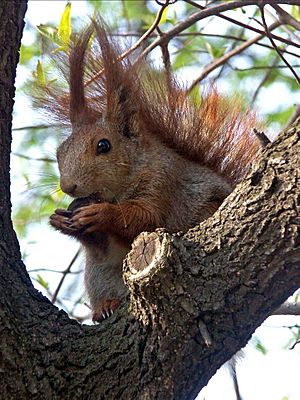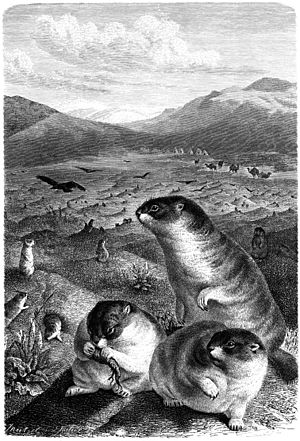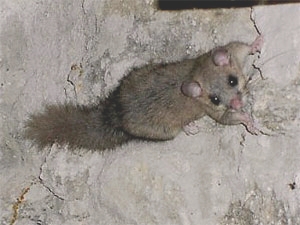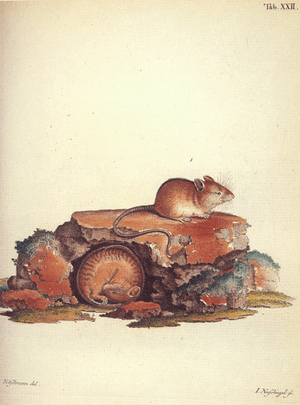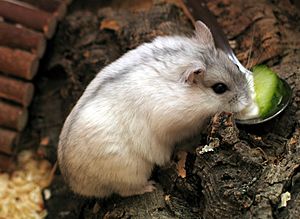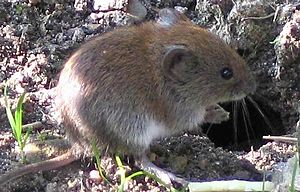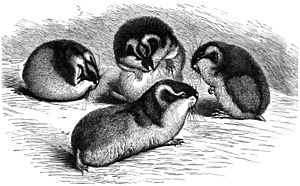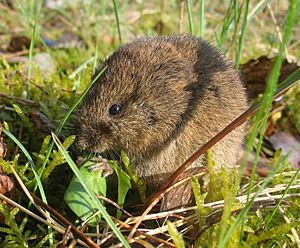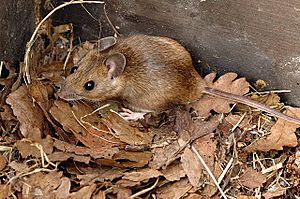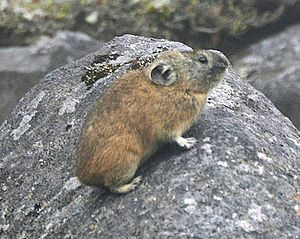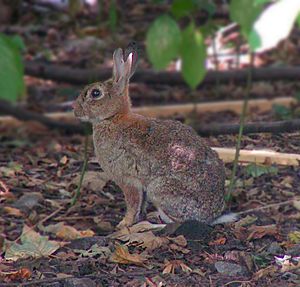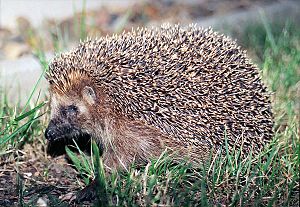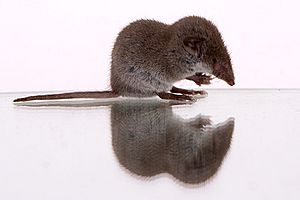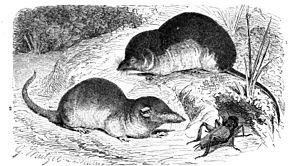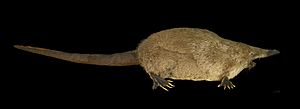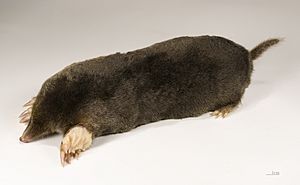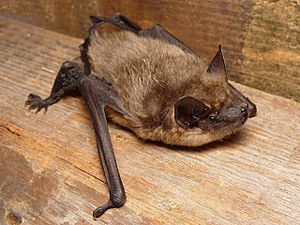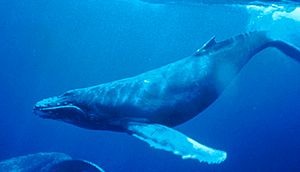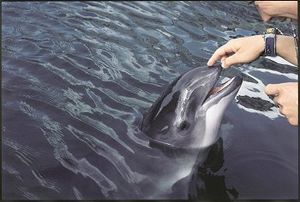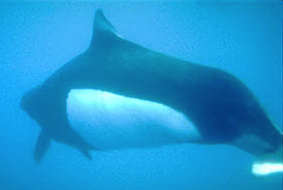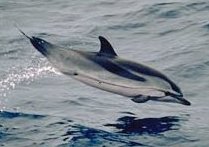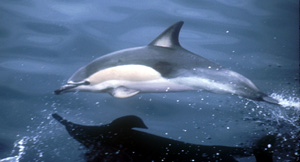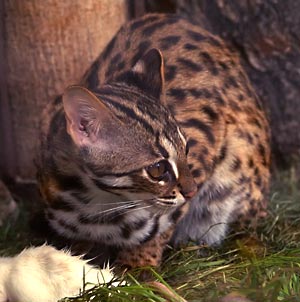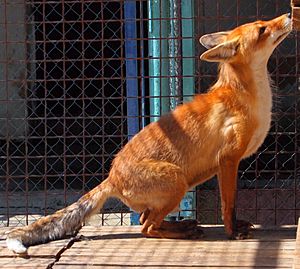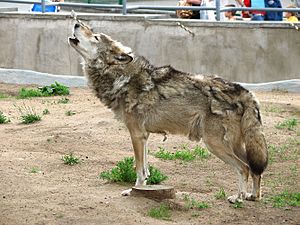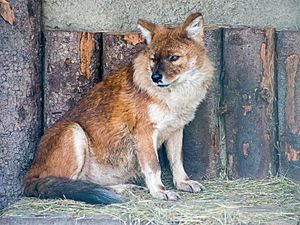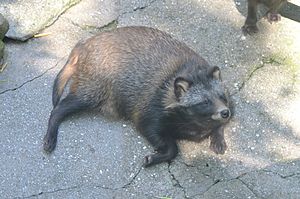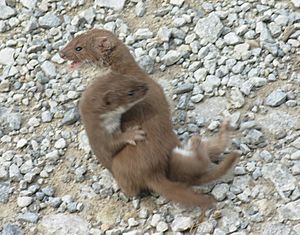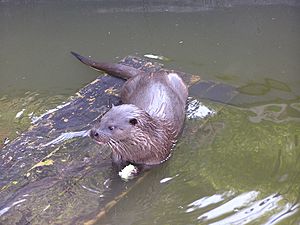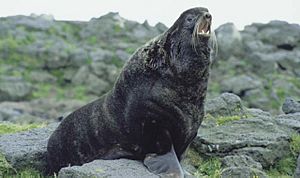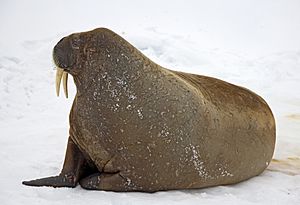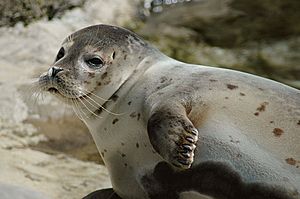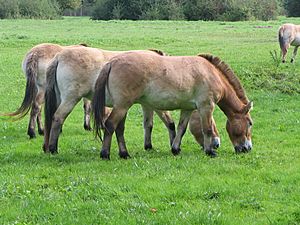List of mammals of Russia facts for kids

Welcome to the amazing world of mammals found in Russia! Russia is a huge country, and it's home to a wide variety of animals. You'll find 266 different kinds of mammals living here.
Sadly, some of these animals are in danger. Five species are critically endangered, meaning they are very close to disappearing forever. Thirteen are endangered, and twenty-six are vulnerable. Six species are near threatened, which means they might be in danger soon. One mammal that used to live in Russia is now extinct, and another can no longer be found in the wild.
All the mammals in Russia belong to a group called placental mammals. This means the babies grow inside their mother and get food and oxygen through a special organ called a placenta.
To help you understand how safe or in danger each animal is, we use special tags from the International Union for Conservation of Nature (IUCN). Here's what they mean:
| EX | Extinct | This animal is gone forever. The last one has died. |
| EW | Extinct in the wild | This animal only lives in zoos or special protected areas. You won't find it in nature anymore. |
| CR | Critically endangered | This animal is in extreme danger of disappearing from the wild very soon. |
| EN | Endangered | This animal faces a very high risk of disappearing from the wild. |
| VU | Vulnerable | This animal is at a high risk of disappearing from the wild. |
| NT | Near threatened | This animal isn't in immediate danger, but it might be in the future. |
| LC | Least concern | This animal is doing well, and there are no big worries about it right now. |
| DD | Data deficient | We don't have enough information to know if this animal is in danger or not. |
Contents
- Order: Rodentia (Rodents)
- Order: Lagomorpha (Lagomorphs)
- Order: Eulipotyphla (Shrews, Hedgehogs, Moles)
- Order: Chiroptera (Bats)
- Order: Cetacea (Whales, Dolphins, Porpoises)
- Order: Carnivora (Carnivores)
- Order: Perissodactyla (Odd-toed Ungulates)
- Order: Artiodactyla (Even-toed Ungulates)
- Animals No Longer Found in Russia
- See also
Order: Rodentia (Rodents)
Rodents are the largest group of mammals. More than 40% of all mammal species are rodents! They have two special front teeth (incisors) in their upper and lower jaws. These teeth never stop growing, so rodents have to keep gnawing to keep them short. Most rodents are small, but some, like the capybara, can be quite large.
Rodent Families in Russia
- Family: Castoridae (Beavers)
- Eurasian beaver, Castor fiber
- Family: Sciuridae (Squirrels)
- Red squirrel, Sciurus vulgaris
- Siberian flying squirrel, Pteromys volans
- Bobak marmot, Marmota bobak
- Siberian chipmunk, Eutamias sibiricus
- Family: Gliridae (Dormice)
- European edible dormouse, Glis glis
- Family: Dipodidae (Jerboas)
- Great jerboa, Allactaga major
- Northern birch mouse, Sicista betulina
- Family: Spalacidae (Mole Rats and Zokors)
- Russian mole rat, Spalax giganteus
- Family: Cricetidae (Hamsters and Voles)
- European hamster, Cricetus cricetus
- Winter white Russian dwarf hamster, Phodopus sungorus
- European water vole, Arvicola amphibius
- Bank vole, Clethrionomys glareolus
- Norway lemming, Lemmus lemmus
- Common vole, Microtus arvalis
- Family: Muridae (Mice and Rats)
- Yellow-necked mouse, Apodemus flavicollis
- Eurasian harvest mouse, Micromys minutus
- Brown rat, Rattus norvegicus (introduced)
Order: Lagomorpha (Lagomorphs)
Lagomorphs include hares, rabbits, and pikas. They might look a bit like rodents, but they are actually a separate group. One key difference is that lagomorphs have four front teeth in their upper jaw, while rodents only have two.
Lagomorph Families in Russia
- Family: Leporidae (Rabbits, Hares)
- European hare, Lepus europaeus
- Mountain hare, Lepus timidus
- European rabbit, Oryctolagus cuniculus (introduced)
- Family: Ochotonidae (Pikas)
- Northern pika, Ochotona hyperborea
Order: Eulipotyphla (Shrews, Hedgehogs, Moles)
Eulipotyphlans are mammals that mostly eat insects. Hedgehogs are known for their spiny coats, while shrews look a bit like mice. Moles are strong burrowers that live underground.
Eulipotyphlan Families in Russia
- Family: Erinaceidae (Hedgehogs)
- West European hedgehog, Erinaceus europaeus
- Family: Soricidae (Shrews)
- Lesser white-toothed shrew, Crocidura suaveolens
- Common shrew, Sorex araneus
- Eurasian water shrew, Neomys fodiens
- Family: Talpidae (Moles)
- Russian desman, Desmana moschata VU
- European mole, Talpa europaea
Order: Chiroptera (Bats)
Bats are unique because they are the only mammals that can truly fly! Their front limbs have developed into wings. About 20% of all mammal species are bats.
Bat Families in Russia
- Family: Vespertilionidae (Common Bats)
- Daubenton's bat, Myotis daubentonii
- Western barbastelle, Barbastella barbastellus
- Serotine bat, Eptesicus serotinus
- Common noctule, Nyctalus noctula
- Brown long-eared bat, Plecotus auritus
- Ussuri tube-nosed bat, Murina ussuriensis EN
- Family: Molossidae (Free-tailed Bats)
- European free-tailed bat, Tadarida teniotis
- Family: Rhinolophidae (Horseshoe Bats)
- Greater horseshoe bat, Rhinolophus ferrumequinum
Order: Cetacea (Whales, Dolphins, Porpoises)

This order includes all the amazing animals that live entirely in water, like whales, dolphins, and porpoises. They have sleek, hairless bodies, a thick layer of blubber for warmth, and their front limbs and tails are shaped for swimming.
Whale and Dolphin Families in Russia
- Suborder: Mysticeti (Baleen Whales)
- These whales have baleen plates instead of teeth to filter tiny food from the water.
- Bowhead whale, Balaena mysticetus
- North Pacific right whale, Eubalaena japonica EN
- Blue whale, Balaenoptera musculus EN
- Humpback whale, Megaptera novaeangliae VU
- Gray whale, Eschrichtius robustus
- These whales have baleen plates instead of teeth to filter tiny food from the water.
- Suborder: Odontoceti (Toothed Whales)
- These whales have teeth and hunt their prey.
- Sperm whale, Physeter macrocephalus VU
- Narwhal, Monodon monoceros DD
- Beluga, Delphinapterus leucas VU
- Harbour porpoise, Phocoena phocoena VU
- Dall's porpoise, Phocoenoides dalli
- Orca, Orcinus orca
- Striped dolphin, Stenella coeruleoalba
- Short-beaked common dolphin, Delphinus delphis
- These whales have teeth and hunt their prey.
Order: Carnivora (Carnivores)
Carnivores are mammals that mostly eat meat. They have special teeth and skull shapes that help them hunt and eat other animals. There are over 260 different kinds of carnivores.
Carnivore Families in Russia
- Family: Felidae (Cats)
- European wildcat, Felis silvestris
- Eurasian lynx, Lynx lynx
- Pallas's cat, Otocolobus manul
- Leopard cat, Prionailurus bengalensis
- Amur leopard, Panthera pardus orientalis
- Siberian tiger, Panthera tigris tigris
- Snow leopard, Panthera uncia
- Family: Canidae (Dogs, Foxes)
- Red fox, Vulpes vulpes
- Arctic fox, Vulpes lagopus
- Raccoon dog, Nyctereutes procyonoides
- Gray wolf, Canis lupus
- Family: Ursidae (Bears)
- Brown bear, Ursus arctos
- Polar bear, Ursus maritimus
- Asiatic black bear, Ursus thibetanus
- Family: Mustelidae (Weasels, Otters, Badgers)
- Sea otter, Enhydra lutris
- Wolverine, Gulo gulo
- Eurasian otter, Lutra lutra
- Sable, Martes zibellina
- European badger, Meles meles
- Least weasel, Mustela nivalis
- Family: Otariidae (Eared Seals, Sea Lions)
- Northern fur seal, Callorhinus ursinus
- Steller sea lion, Eumetopias jubatus
- Family: Odobenidae (Walrus)
- Walrus, Odobenus rosmarus
- Family: Phocidae (Earless Seals)
- Bearded seal, Erignathus barbatus
- Grey seal, Halichoerus grypus
- Common seal, Phoca vitulina
- Baikal seal, Pusa sibirica
Order: Perissodactyla (Odd-toed Ungulates)
Odd-toed ungulates are large mammals that eat plants. Their weight is mostly carried on their middle toe. They have simple stomachs.
Odd-toed Ungulate Families in Russia
- Family: Equidae (Horses)
- Wild horse, Equus ferus (reintroduced)
- Onager, Equus hemionus
Order: Artiodactyla (Even-toed Ungulates)
Even-toed ungulates are also plant-eating mammals. Their weight is spread evenly across their third and fourth toes. Many of these animals are very important to humans, like cattle and sheep.
Even-toed Ungulate Families in Russia
- Family: Suidae (Pigs)
- Wild boar, Sus scrofa
- Family: Moschidae (Musk Deer)
- Siberian musk deer, Moschus moschiferus
- Family: Cervidae (Deer)
- Family: Bovidae (Cattle, Antelopes, Sheep, Goats)
- Saiga antelope, Saiga tatarica
- European bison, Bison bonasus (reintroduced)
- Wild goat, Capra aegagrus
- West Caucasian tur, Capra caucasica
- Siberian ibex, Capra sibrica
- Muskox, Ovibos moschatus
- Argali, Ovis ammon
- Chamois, Rupicapra rupicapra
Animals No Longer Found in Russia
Some mammal species that once lived in Russia are now gone.
Locally Extinct (No Longer in the Wild in Russia)
- Wild yak, Bos mutus
- Dhole, Cuon alpinus
- Mediterranean monk seal, Monachus monachus
Extinct (Gone Forever)
- Aurochs, Bos primigenius
- Steller's sea cow, Hydrodamalis gigas
- Japanese sea lion, Zalophus japonicus
|
See also
- List of chordate orders
- Lists of mammals by region
- List of prehistoric mammals
- Mammal classification
- List of mammals described in the 2000s


